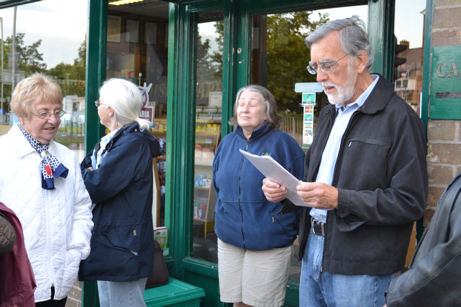
| Trumpington Local History Group Walk Around the Village Centre, 2011 |
| Copyright © Trumpington Local History Group, 2014. Updated 3 July 2014. Email: admin@trumpingtonlocalhistorygroup.org |
These notes are based on presentations by
members of the Local History Group who
led a guided walk around the centre of the
village on 23 June 2011.
The walk started at the Church Bakehouse
in Grantchester Road and went in a
clockwise route along Church Lane to the
War Memorial then the High Street and
Maris Lane.
members of the Local History Group who
led a guided walk around the centre of the
village on 23 June 2011.
The walk started at the Church Bakehouse
in Grantchester Road and went in a
clockwise route along Church Lane to the
War Memorial then the High Street and
Maris Lane.
| Poster designed by Sheila Glasswell. |
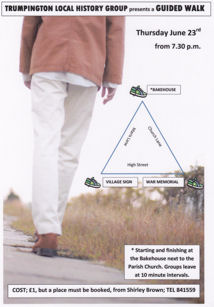
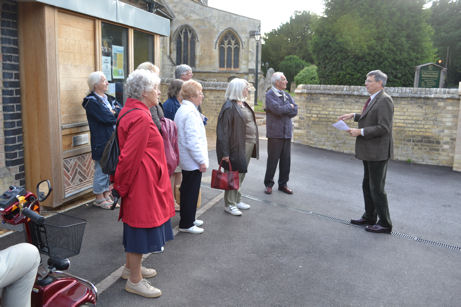
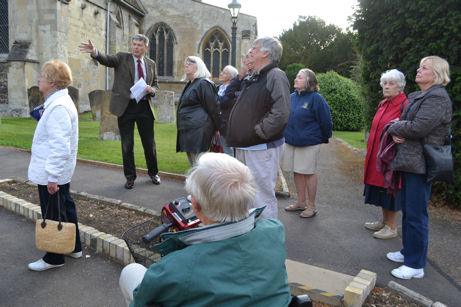
Grantchester Road
Edmund Brookes
Edmund Brookes
| Edmund Brookes and one of the groups outside The Bakehouse and in the churchyard. Photos: Andrew Roberts. |
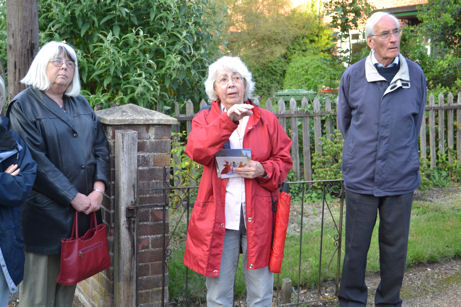
| Shirley Brown in Church Lane opposite The Unicorn. Photo: Andrew Roberts. |
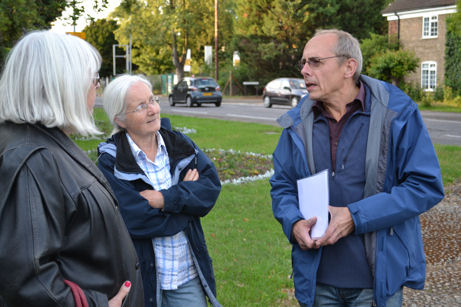

| Arthur Brookes by the War Memorial. Photos: Andrew Roberts. |
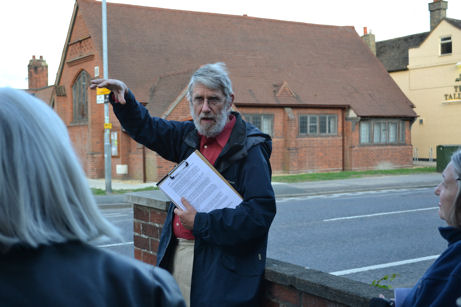
| Howard Slatter outside Bidwells, opposite the Village Hall. Photo: Andrew Roberts. |
| Peter Dawson outside the pharmacy. Photo: Andrew Roberts. |
| Andrew Roberts by the junction with Maris Lane. Photo: Wendy Roberts. |
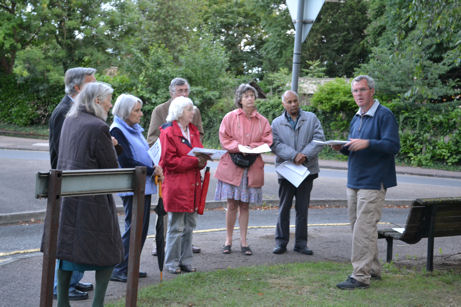


| Left: the centre of the village in the early 19th century. A Map of the Parish of Trumpington in the County of Cambridge, 1804. Cambridgeshire Archives, R60/24/2/70(a). Reproduced by permission of Cambridgeshire Archives. Right: the centre of the village in the early 20th century. Inland Revenue Land Value map for Trumpington, 1910-11. Cambridgeshire Archives, file 470/047, sheet XLVII.10. Reproduced by permission of Cambridgeshire Archives. |
Anstey Hall Farm
Main north end range may be of 17th century, north west wing 18th century. The thatched
barn is 17/18th century. In 1881, this was a 380 acre farm, but most of the land went to form
the Plant Breeding Institute (PBI) and under Tom Parsons it became a specialist pig farm. The
Dovecote 17/18th century on the Grantchester side was restored in 1984, it is interesting that
there are no entrances for birds!
The Church
See the History of the Church.
The Vicarage
Sold in 2009, basically a Queen Ann/Georgian building but changed a lot and essentially in 3
parts. 18th Century north wing where kitchen was demolished by Reverend Bury around 1900,
when a large part of the Vicarage Garden was sold to Mr Foster of Anstey Hall, also southern
block added. Kitchen Garden became new graveyard in early 1990s.
The Bakehouse
This building was outbuildings, garage and small meeting room which was used until 1980's
then in disuse. Probably dates from 19th century. The Church of England Mens' Society met
there. Room refurbished to hold Godly Play in early 2000s. Retained by the Church except two
sheds when the Vicarage was sold. Converted to a very high standard as an office and meeting
room.
Farm cottages and houses
The large house set back from the road, number 18, is dated 1654, the thatched cottages are
17th century and were restored many years ago. Reverend King lived in the end one.
The Church School
Land bought 1842 for a National School and opened 1843, extended 1868 with a room at the
back. Always known as The Church School. Had 1 room divisible in the original building and 1
in the extension. Closed in 1950 after Fawcett School opened in 1949, Mr Youngs, stayed on in
the School House. Became Cambridgeshire Farm School until the 1970s when that moved to
Milton. Building refurbished and added to in early 1970s when Miss Willers died (new toilets,
committee room, and kitchen, one bay reroofed). Kitchen again refurbished in early 1990s,
leased to Rainbow Nursery in 2005.
School House
Built in 1857 by L. Gary & Sons to the design of Butterfield (who re-ordered the Church).
When the school shut, Mr Youngs the headmaster and Church organist continued to live in the
house. Daughter married a Seekings, he went to St Philips as Head and then move to Milton.
Owned by the PCC until sold about 1974. See the separate article about the School House and
William Butterfield.
The Old House
Original building late 16th century, good example of local brick (not Cambridge Commons).
Enlarged in the 17th century and restored in 1924 when extension on south west end entirely
rebuilt. It used to be called Lady Southwell's house (Sir Francis Pemberton's half-sister).
Re-roofed in the early 2000s.
Church Lane
Shirley Brown
Main north end range may be of 17th century, north west wing 18th century. The thatched
barn is 17/18th century. In 1881, this was a 380 acre farm, but most of the land went to form
the Plant Breeding Institute (PBI) and under Tom Parsons it became a specialist pig farm. The
Dovecote 17/18th century on the Grantchester side was restored in 1984, it is interesting that
there are no entrances for birds!
The Church
See the History of the Church.
The Vicarage
Sold in 2009, basically a Queen Ann/Georgian building but changed a lot and essentially in 3
parts. 18th Century north wing where kitchen was demolished by Reverend Bury around 1900,
when a large part of the Vicarage Garden was sold to Mr Foster of Anstey Hall, also southern
block added. Kitchen Garden became new graveyard in early 1990s.
The Bakehouse
This building was outbuildings, garage and small meeting room which was used until 1980's
then in disuse. Probably dates from 19th century. The Church of England Mens' Society met
there. Room refurbished to hold Godly Play in early 2000s. Retained by the Church except two
sheds when the Vicarage was sold. Converted to a very high standard as an office and meeting
room.
Farm cottages and houses
The large house set back from the road, number 18, is dated 1654, the thatched cottages are
17th century and were restored many years ago. Reverend King lived in the end one.
The Church School
Land bought 1842 for a National School and opened 1843, extended 1868 with a room at the
back. Always known as The Church School. Had 1 room divisible in the original building and 1
in the extension. Closed in 1950 after Fawcett School opened in 1949, Mr Youngs, stayed on in
the School House. Became Cambridgeshire Farm School until the 1970s when that moved to
Milton. Building refurbished and added to in early 1970s when Miss Willers died (new toilets,
committee room, and kitchen, one bay reroofed). Kitchen again refurbished in early 1990s,
leased to Rainbow Nursery in 2005.
School House
Built in 1857 by L. Gary & Sons to the design of Butterfield (who re-ordered the Church).
When the school shut, Mr Youngs the headmaster and Church organist continued to live in the
house. Daughter married a Seekings, he went to St Philips as Head and then move to Milton.
Owned by the PCC until sold about 1974. See the separate article about the School House and
William Butterfield.
The Old House
Original building late 16th century, good example of local brick (not Cambridge Commons).
Enlarged in the 17th century and restored in 1924 when extension on south west end entirely
rebuilt. It used to be called Lady Southwell's house (Sir Francis Pemberton's half-sister).
Re-roofed in the early 2000s.
Church Lane
Shirley Brown
We know the Village School (now a Nursery) was built in 1842. I assume the Unicorn was built
about the same time, as the two pieces of land were up for sale at the same time.
The Unicorn had stables on the boundary with the school house. The first stable was rented by
a butcher for a time, later used as a fish and chip shop. In the 1930s the small building opposite
became the fish and chip shop. By the 1970s it was a barber's. The current Unicorn car park
was once a well-used bowling green. There was a hall to the right of the pub used by visiting
bowls teams and the Friendly Society known as "The Foresters".
An old blacksmith's forge stood on the High Street just beyond the lodge gates. Beside it were
the stocks and whipping post and within Trumpington Park, the village pound. The forge was
taken down in 1855 when a new forge was built on the High Street.
In 1800 there were several thatched cottages between The Old House and the other end of
Church Lane. In one lived Mother Sivill (or Savill), reputed to be a witch and fortune teller. She
was frequently in trouble with the law and is said to be the last person to stand on the
Cambridge Pillory.
The newer houses were built in the 1960s. Before 1937 Church Lane ran into the High Street
between the War Memorial and the park wall. The War Memorial stands on the exact spot as
the original Village Cross.
The War Memorial
Arthur Brookes
about the same time, as the two pieces of land were up for sale at the same time.
The Unicorn had stables on the boundary with the school house. The first stable was rented by
a butcher for a time, later used as a fish and chip shop. In the 1930s the small building opposite
became the fish and chip shop. By the 1970s it was a barber's. The current Unicorn car park
was once a well-used bowling green. There was a hall to the right of the pub used by visiting
bowls teams and the Friendly Society known as "The Foresters".
An old blacksmith's forge stood on the High Street just beyond the lodge gates. Beside it were
the stocks and whipping post and within Trumpington Park, the village pound. The forge was
taken down in 1855 when a new forge was built on the High Street.
In 1800 there were several thatched cottages between The Old House and the other end of
Church Lane. In one lived Mother Sivill (or Savill), reputed to be a witch and fortune teller. She
was frequently in trouble with the law and is said to be the last person to stand on the
Cambridge Pillory.
The newer houses were built in the 1960s. Before 1937 Church Lane ran into the High Street
between the War Memorial and the park wall. The War Memorial stands on the exact spot as
the original Village Cross.
The War Memorial
Arthur Brookes
For information about the War Memorial, see the separate article on its history by Arthur
Brookes.
The High Street
Howard Slatter
Brookes.
The High Street
Howard Slatter
Smithy
Up to at least 1830 (Baker's map), the smithy was roughly where the lodge house for the park
now stands. A new building was constructed in about 1855 where Bidwells Stone Cross building
now stands.
One of the last blacksmiths (1881-1911 at least) was Elijah Lawrence from Haughley, Suffolk.
He died in 1931 age 89; confusingly, his daughter married his nephew, another Elijah Lawrence,
also a blacksmith. Benjamin Stone and Lewis Andrews were Elijah Lawrence's assistants in the
early 20th century, and by 1939, Andrews & Stone, farriers & engineers, occupied the smithy.
By 1962, the premises were used by Donald Ramsey, antique furniture restorer. The village
notice board was outside the end wall, facing the war memorial.
1985 proposed demolition, fiercely opposed by people in the village. Decision by City Council
was tied, casting vote by mayor Peter Cowell, who described it as a "scruffy place". Demolished
in 1986, only the wall at the end survives.
Manor Farm
To north of the present Beverley Way. The milking herd of cows there in the 1940s and 1950s
(farmer Bert Cornwell) had to cross the main road to and from pasturing in the Park. The land
of the farm extended to the east, over much of the present estate and school land. A drift road
went down the line of Beverley Way, through to what is now Paget Road, and on across the
fields along the present Addenbrooke's track, heading for Red Cross farm on Hills Road.
Thatched barn burned down in about 1963 and never rebuilt (Antony Pemberton recalls driving
back to Cambridge from London with his father, and seeing the plume of smoke - they feared it
might be the Hall itself which was on fire). Some of the farm buildings were demolished in
1968-69, then the farm house and barn by 1971, leading to the building Beverley Way by 1975
and the other houses further north. (Plans for a motel on the site as far as the Villa Service
station had been rejected in 1974).
Village Hall
The Village Hall opened in 1908 at a cost of £922 as a Men's Institute, for playing games and
reading (women admitted for whist drives!). In 1924 a billiard room, kitchen and cloakroom
were added, and the Jubilee Room in 1978. Used as a schoolroom for evacuees from Muswell
Hill in 1939-40. The Local History Group organised an excellent exhibition there for the
centenary in October 2008.
Behind, where the doctors' surgery now stands, were two wooden huts. The first was erected
for the Army Cadet Force (ACF) after the War and the second for the Scouts in 1957. The
scouts eventually took both over; cubs and scouts finally ended in 1995, after over 80 years in
the village.
Tally Ho!
Opened as a pub by at latest 1841, the building appears on the 1809 Inclosure map. Originally
also a brewery at the back. Bay window added in about the 1930s.
West side houses
Coming down from the smithy there was a line of 6 houses, occupied in the early 20th century
by, among others, Mr Henry Saunders' Post Office and Mr Albert Day's bakery. Behind them
was a large Mission Hall, marked on the 1885 OS map as a chapel. Mr Day knocked down the
three houses next to his shop in the 1930s and built a new shop which later became the Co-op
and is now the Hobbies Stores.
The next block of 3 houses was erected in the 1860s; no. 42 was the home of the Matthews
family: Mrs Elizabeth Matthews was widowed in 1898 when her husband Ellis Matthews, a
shepherd, died. She then set up a laundry using the land behind the houses and brought up her
seven children on her own.
Whitlocks
In 1728 George Whitelock willed his house to provide 34 poor households with coal, the coal to
be of the cheapest! Coats with brass buttons were also given annually to 6 widowed persons and
8 boys. Whitelock's house and malting were reconstructed in 1819 to be let as 20 cottages to
poor people and the land to be let as allotments. Later in the 19th century they were rebuilt as
13 cottages and 4 almshouses fronting the High Street. Known as "Whitelock's Yard" or
"Workhouse Yard".
In 1963 the site was sold to the City Council, who by 1968 had built "Whitlocks", a block with
bed-sit accommodation for people over the age of 60 ("White locks", it was said, might be seen
as a derogatory comment on older people). In later years it was used to house student nurses
and refugees. The new apartment block was built in the mid 2000s, the 5th use of this site in the
last 200 years.
East side houses and Swan's Yard
In the early 19th century this was still open farmland. The first building here was a terrace of 7
houses, set back at right angles to the road, called "Swan's Yard"; this survived until at least
1948. Then, in the 1850's, two pairs of cottages were built, one either side of Swan's Yard; by
1871 the next pair had filled the gap up to the Tally Ho and by 1881 the next block of four
further south had been built. Those have now been converted into just two houses and
refurbished.
The former number 89 was occupied by two generations of the Parker family from its
construction in the 1850's right up to 1947. William Parker, a shepherd from Great Wilbraham,
and his wife Sophia with their children were succeeded by their son Irwin Parker and his wife
Ethel; Ethel died in 1947, age 79. The porch on that pair was knocked off by an articulated lorry
and never replaced.
Between 1871 and 1901 the village policeman lived in one or other of these houses, before
moving to a police house in Church Lane.
The High Street
Peter Dawson
Up to at least 1830 (Baker's map), the smithy was roughly where the lodge house for the park
now stands. A new building was constructed in about 1855 where Bidwells Stone Cross building
now stands.
One of the last blacksmiths (1881-1911 at least) was Elijah Lawrence from Haughley, Suffolk.
He died in 1931 age 89; confusingly, his daughter married his nephew, another Elijah Lawrence,
also a blacksmith. Benjamin Stone and Lewis Andrews were Elijah Lawrence's assistants in the
early 20th century, and by 1939, Andrews & Stone, farriers & engineers, occupied the smithy.
By 1962, the premises were used by Donald Ramsey, antique furniture restorer. The village
notice board was outside the end wall, facing the war memorial.
1985 proposed demolition, fiercely opposed by people in the village. Decision by City Council
was tied, casting vote by mayor Peter Cowell, who described it as a "scruffy place". Demolished
in 1986, only the wall at the end survives.
Manor Farm
To north of the present Beverley Way. The milking herd of cows there in the 1940s and 1950s
(farmer Bert Cornwell) had to cross the main road to and from pasturing in the Park. The land
of the farm extended to the east, over much of the present estate and school land. A drift road
went down the line of Beverley Way, through to what is now Paget Road, and on across the
fields along the present Addenbrooke's track, heading for Red Cross farm on Hills Road.
Thatched barn burned down in about 1963 and never rebuilt (Antony Pemberton recalls driving
back to Cambridge from London with his father, and seeing the plume of smoke - they feared it
might be the Hall itself which was on fire). Some of the farm buildings were demolished in
1968-69, then the farm house and barn by 1971, leading to the building Beverley Way by 1975
and the other houses further north. (Plans for a motel on the site as far as the Villa Service
station had been rejected in 1974).
Village Hall
The Village Hall opened in 1908 at a cost of £922 as a Men's Institute, for playing games and
reading (women admitted for whist drives!). In 1924 a billiard room, kitchen and cloakroom
were added, and the Jubilee Room in 1978. Used as a schoolroom for evacuees from Muswell
Hill in 1939-40. The Local History Group organised an excellent exhibition there for the
centenary in October 2008.
Behind, where the doctors' surgery now stands, were two wooden huts. The first was erected
for the Army Cadet Force (ACF) after the War and the second for the Scouts in 1957. The
scouts eventually took both over; cubs and scouts finally ended in 1995, after over 80 years in
the village.
Tally Ho!
Opened as a pub by at latest 1841, the building appears on the 1809 Inclosure map. Originally
also a brewery at the back. Bay window added in about the 1930s.
West side houses
Coming down from the smithy there was a line of 6 houses, occupied in the early 20th century
by, among others, Mr Henry Saunders' Post Office and Mr Albert Day's bakery. Behind them
was a large Mission Hall, marked on the 1885 OS map as a chapel. Mr Day knocked down the
three houses next to his shop in the 1930s and built a new shop which later became the Co-op
and is now the Hobbies Stores.
The next block of 3 houses was erected in the 1860s; no. 42 was the home of the Matthews
family: Mrs Elizabeth Matthews was widowed in 1898 when her husband Ellis Matthews, a
shepherd, died. She then set up a laundry using the land behind the houses and brought up her
seven children on her own.
Whitlocks
In 1728 George Whitelock willed his house to provide 34 poor households with coal, the coal to
be of the cheapest! Coats with brass buttons were also given annually to 6 widowed persons and
8 boys. Whitelock's house and malting were reconstructed in 1819 to be let as 20 cottages to
poor people and the land to be let as allotments. Later in the 19th century they were rebuilt as
13 cottages and 4 almshouses fronting the High Street. Known as "Whitelock's Yard" or
"Workhouse Yard".
In 1963 the site was sold to the City Council, who by 1968 had built "Whitlocks", a block with
bed-sit accommodation for people over the age of 60 ("White locks", it was said, might be seen
as a derogatory comment on older people). In later years it was used to house student nurses
and refugees. The new apartment block was built in the mid 2000s, the 5th use of this site in the
last 200 years.
East side houses and Swan's Yard
In the early 19th century this was still open farmland. The first building here was a terrace of 7
houses, set back at right angles to the road, called "Swan's Yard"; this survived until at least
1948. Then, in the 1850's, two pairs of cottages were built, one either side of Swan's Yard; by
1871 the next pair had filled the gap up to the Tally Ho and by 1881 the next block of four
further south had been built. Those have now been converted into just two houses and
refurbished.
The former number 89 was occupied by two generations of the Parker family from its
construction in the 1850's right up to 1947. William Parker, a shepherd from Great Wilbraham,
and his wife Sophia with their children were succeeded by their son Irwin Parker and his wife
Ethel; Ethel died in 1947, age 79. The porch on that pair was knocked off by an articulated lorry
and never replaced.
Between 1871 and 1901 the village policeman lived in one or other of these houses, before
moving to a police house in Church Lane.
The High Street
Peter Dawson
Thatched cottage
The thatched cottage to the right of the pharmacy was probably built in the late 18th or early
19th century. The 1891 and 1911 censuses record the Gentle family as tenants and in 1939
Herbert Gentle, a tailor, was registered here. Not surprisingly, it became known as Gentle's
Cottage. It was last re-thatched in the 1980s and the inevitable sagging of the roof's ridge over
the years is now disguised by thatch 36 inches thick at the centre. There were grooves in the
original brick floor caused by running water which visitors were fooled into believing was the
work of "brick-worms".
In the 1950s, Mr Gentle, who was deaf and dumb, reportedly installed a hi-tec alert system
where pressing the door-bell actuated a ping-pong ball which moved across his head. Another,
less likely, story suggests the device was actually a string attached to the leg of his caged budgie,
causing the unfortunate bird to fly up with an unheard squawk.
In 1977, the cottage was converted into an art gallery and picture framers. The new incumbents
had a shock on discovering Mr Gentle's Colt 45 service revolver in the old bread oven. In 1993,
the business relocated to Mitcham's Corner, Chesterton, but retained the name "Trumpington
Gallery". The cottage has subsequently been used for other purposes including a house hunting
service.
Cycle shop/petrol station
There was a brick- and wood-built cycle shop next door to the cottage, run from the 1920s by
Harry Newell. It was guarded by his dog when he was out. Moving with the times, Harry
extended the building upwards, added a petrol pump and a sign saying "Garage" thus becoming
officially a "Motor Engineer and Cycle Agent". His many activities included a taxi service
deploying a series of large cars including, at one time, a Daimler: the uses included transporting
cricket teams and as a hearse, although for funerals the coffin would be moved on a handcart
pushed by Harry.
There is a pre-War photograph in Trumpington in Old Picture Postcards of a dapper young man
having the tank of his very flashy sports car filled. This was Frank Whittle, later Sir Frank,
inventor of the turbo-jet engine. In contrast, at an earlier date, Harry Newell would tow his
elderly father around in a wheelchair attached to his bicycle, even venturing as far as London.
Lock-up
Adjoining the Newell's shop was the historic tiny brick-built village lock-up. Comfort was at a
premium inside the lock-up as the only source of light and ventilation was a small barred circular
window over the door. A single "guest" would be secured by a padlocked iron strap to the
primitive pillory post and seat.
The lock-up was last used in the 19th century when a very drunken villager was locked-up
overnight to sober him up. The next morning he was found to be in an even worse state, having
been supplied with more beer by his mates using a rubber tube passed through the window.
In the early 20th century, the lock-up served as a store for games equipment and, later, Harry
Newell's stock of paraffin.
Wood-yard
There was a wood-yard to the left of the lock-up where, in the early 1900s, the business of E.J.
Smith & Sons thrived beneath a large (chestnut?) tree. The Smiths were very versatile, working
as carpenters, wheelwrights, cart-builders and undertakers. They made coffins and Selfridges in
London sold their wheelbarrows at one time, indicating the quality of their work. The yard
closed down in the 1950s and the carpentry business moved to the nearby smithy.
Opposite here, on the east side of the High Street, there was a large Recreation Ground in the
area now occupied by the Anstey Way shops and the entrance to the estate. Noble's small
newsagents and confectionery shop was at the corner. There was an area with communal
washing lines.
The cricket pitch was well maintained but the outfield was described in Walter Dring's memoirs
of his early 1920s boyhood as "Indian Country" where balls were frequently lost in the very long
grass and sometimes conveniently found by fielders just as the batsmen were running mid-way
between the creases. Edwin Smith's sons were excellent cricketers, Gordon, a bowler, and Cliff,
a batsman of renown who later played for his county. During village matches, Cliff was expected
to wallop the ball for six right across the road and land it on his Dad's shed roof.
Present day buildings
In 1955, a plan for a modern petrol station which required the demolition of the iconic lock-up
was rejected. However, in 1957 the whole area was redeveloped, including the wood-yard,
Newell's garage and, shamefully, the lock-up. The Shell petrol station was constructed and next
to it a building comprising a cycle shop and general store for Harry Newell and the adjoining
chemist's shop. The thatched cottage was spared.
Later, Shell installed a giant motorway-sized monolithic sign which they were forced to dismantle
and replace with the existing smaller version after the Trumpington Environmental Action Group
(TEAG) lodged an objection. It is unfortunate TEAG was not in being when the lock-up and old
smithy were so wantonly destroyed.
Until he retired, Harry Newell, ever the entrepreneur, sold a wide variety of goods. Cycles and
spares, hardware, ironmongery, seeds, garden tools, stains and polishes were all available to an
appreciative local community. After Harry left, the building was used by a string of businesses
which had varying success, including an electrical contractor, a haberdashery, an auctioneers and
a leisureware outlet. The award-winning fine wine merchant, Noel Young, successfully
established his enterprising business in 1992. The first dispensing chemist was Harold Moore,
with Jeffrey and Karen Gregory taking over the pharmacy on Mr Moore's retirement in 1986.
Jeffrey Gregory has enhanced Trumpington's amenities by qualifying as an optician and now has
a well-equipped room for sight-testing.
The Village Sign, High Street and Maris Lane
Andrew Roberts
The thatched cottage to the right of the pharmacy was probably built in the late 18th or early
19th century. The 1891 and 1911 censuses record the Gentle family as tenants and in 1939
Herbert Gentle, a tailor, was registered here. Not surprisingly, it became known as Gentle's
Cottage. It was last re-thatched in the 1980s and the inevitable sagging of the roof's ridge over
the years is now disguised by thatch 36 inches thick at the centre. There were grooves in the
original brick floor caused by running water which visitors were fooled into believing was the
work of "brick-worms".
In the 1950s, Mr Gentle, who was deaf and dumb, reportedly installed a hi-tec alert system
where pressing the door-bell actuated a ping-pong ball which moved across his head. Another,
less likely, story suggests the device was actually a string attached to the leg of his caged budgie,
causing the unfortunate bird to fly up with an unheard squawk.
In 1977, the cottage was converted into an art gallery and picture framers. The new incumbents
had a shock on discovering Mr Gentle's Colt 45 service revolver in the old bread oven. In 1993,
the business relocated to Mitcham's Corner, Chesterton, but retained the name "Trumpington
Gallery". The cottage has subsequently been used for other purposes including a house hunting
service.
Cycle shop/petrol station
There was a brick- and wood-built cycle shop next door to the cottage, run from the 1920s by
Harry Newell. It was guarded by his dog when he was out. Moving with the times, Harry
extended the building upwards, added a petrol pump and a sign saying "Garage" thus becoming
officially a "Motor Engineer and Cycle Agent". His many activities included a taxi service
deploying a series of large cars including, at one time, a Daimler: the uses included transporting
cricket teams and as a hearse, although for funerals the coffin would be moved on a handcart
pushed by Harry.
There is a pre-War photograph in Trumpington in Old Picture Postcards of a dapper young man
having the tank of his very flashy sports car filled. This was Frank Whittle, later Sir Frank,
inventor of the turbo-jet engine. In contrast, at an earlier date, Harry Newell would tow his
elderly father around in a wheelchair attached to his bicycle, even venturing as far as London.
Lock-up
Adjoining the Newell's shop was the historic tiny brick-built village lock-up. Comfort was at a
premium inside the lock-up as the only source of light and ventilation was a small barred circular
window over the door. A single "guest" would be secured by a padlocked iron strap to the
primitive pillory post and seat.
The lock-up was last used in the 19th century when a very drunken villager was locked-up
overnight to sober him up. The next morning he was found to be in an even worse state, having
been supplied with more beer by his mates using a rubber tube passed through the window.
In the early 20th century, the lock-up served as a store for games equipment and, later, Harry
Newell's stock of paraffin.
Wood-yard
There was a wood-yard to the left of the lock-up where, in the early 1900s, the business of E.J.
Smith & Sons thrived beneath a large (chestnut?) tree. The Smiths were very versatile, working
as carpenters, wheelwrights, cart-builders and undertakers. They made coffins and Selfridges in
London sold their wheelbarrows at one time, indicating the quality of their work. The yard
closed down in the 1950s and the carpentry business moved to the nearby smithy.
Opposite here, on the east side of the High Street, there was a large Recreation Ground in the
area now occupied by the Anstey Way shops and the entrance to the estate. Noble's small
newsagents and confectionery shop was at the corner. There was an area with communal
washing lines.
The cricket pitch was well maintained but the outfield was described in Walter Dring's memoirs
of his early 1920s boyhood as "Indian Country" where balls were frequently lost in the very long
grass and sometimes conveniently found by fielders just as the batsmen were running mid-way
between the creases. Edwin Smith's sons were excellent cricketers, Gordon, a bowler, and Cliff,
a batsman of renown who later played for his county. During village matches, Cliff was expected
to wallop the ball for six right across the road and land it on his Dad's shed roof.
Present day buildings
In 1955, a plan for a modern petrol station which required the demolition of the iconic lock-up
was rejected. However, in 1957 the whole area was redeveloped, including the wood-yard,
Newell's garage and, shamefully, the lock-up. The Shell petrol station was constructed and next
to it a building comprising a cycle shop and general store for Harry Newell and the adjoining
chemist's shop. The thatched cottage was spared.
Later, Shell installed a giant motorway-sized monolithic sign which they were forced to dismantle
and replace with the existing smaller version after the Trumpington Environmental Action Group
(TEAG) lodged an objection. It is unfortunate TEAG was not in being when the lock-up and old
smithy were so wantonly destroyed.
Until he retired, Harry Newell, ever the entrepreneur, sold a wide variety of goods. Cycles and
spares, hardware, ironmongery, seeds, garden tools, stains and polishes were all available to an
appreciative local community. After Harry left, the building was used by a string of businesses
which had varying success, including an electrical contractor, a haberdashery, an auctioneers and
a leisureware outlet. The award-winning fine wine merchant, Noel Young, successfully
established his enterprising business in 1992. The first dispensing chemist was Harold Moore,
with Jeffrey and Karen Gregory taking over the pharmacy on Mr Moore's retirement in 1986.
Jeffrey Gregory has enhanced Trumpington's amenities by qualifying as an optician and now has
a well-equipped room for sight-testing.
The Village Sign, High Street and Maris Lane
Andrew Roberts
Village Sign
The village sign is in a prominent position on a small green in front of the Bidwells head office,
at the junction of the High Street and Maris Lane.
The current sign was erected in 2010 after a project led by Antony Pemberton, with funding
from the Local History Group, Trumpington Women's Institute, Trumpington Parochial Charity,
Cambridge City Council and other local sources. Designed by Sheila Betts, the sign shows the
figure of Sir Roger de Trumpington on horseback with a shield based on the brass of Sir Roger
in Trumpington Church. It replaced an original sign erected in 1987 after a fund-raising
campaign led by Councillor Betty Suckling.
North-south and east-west crossing point
The sign is at the junction where the main road from London to Cambridge and King's Lynn is
crossed by a route from Great Chesterford to the ford across the River Cam to Grantchester and
further west. These routes have probably been used for over 5000 years, starting as Prehistoric
trackways.
The north-south road follows a ridge along the east side of the river valley which provided a
natural route from Hauxton Mill and ford through Trumpington village to Trumpington Ford on
Vicar's Brook and eventually Trumpington Gate at the entrance to Cambridge (near the junction
of Trumpington Street and Pembroke Street). From the 16th century, regular coach services
developed and in the early 18th century the road became an important turnpike marked with a
line of milestones, three of which were placed within the parish. The Great Chesterford road
also became a turnpike at the same time, marked by a second set of rather plainer milestones. A
tollkeeper's house and weighbridge were built at the then entrance to the village in the early 19th
century. The busy roads supported a number of inns, such as The Green Man and the Coach &
Horses.
The original village developed in the area around the church, gradually extending to the east and
the current main road. The triangle of land between Church Lane, High Street and Maris Lane
was gradually encroached on by housing. By the time of enclosure in the early 19th century, it
was being used for houses and a farm and it was more densely occupied by the early 20th
century. Despite the spread of housing, the village was still dominated by farms and farmland
well into the 20th century.
The village sign is in a prominent position on a small green in front of the Bidwells head office,
at the junction of the High Street and Maris Lane.
The current sign was erected in 2010 after a project led by Antony Pemberton, with funding
from the Local History Group, Trumpington Women's Institute, Trumpington Parochial Charity,
Cambridge City Council and other local sources. Designed by Sheila Betts, the sign shows the
figure of Sir Roger de Trumpington on horseback with a shield based on the brass of Sir Roger
in Trumpington Church. It replaced an original sign erected in 1987 after a fund-raising
campaign led by Councillor Betty Suckling.
North-south and east-west crossing point
The sign is at the junction where the main road from London to Cambridge and King's Lynn is
crossed by a route from Great Chesterford to the ford across the River Cam to Grantchester and
further west. These routes have probably been used for over 5000 years, starting as Prehistoric
trackways.
The north-south road follows a ridge along the east side of the river valley which provided a
natural route from Hauxton Mill and ford through Trumpington village to Trumpington Ford on
Vicar's Brook and eventually Trumpington Gate at the entrance to Cambridge (near the junction
of Trumpington Street and Pembroke Street). From the 16th century, regular coach services
developed and in the early 18th century the road became an important turnpike marked with a
line of milestones, three of which were placed within the parish. The Great Chesterford road
also became a turnpike at the same time, marked by a second set of rather plainer milestones. A
tollkeeper's house and weighbridge were built at the then entrance to the village in the early 19th
century. The busy roads supported a number of inns, such as The Green Man and the Coach &
Horses.
The original village developed in the area around the church, gradually extending to the east and
the current main road. The triangle of land between Church Lane, High Street and Maris Lane
was gradually encroached on by housing. By the time of enclosure in the early 19th century, it
was being used for houses and a farm and it was more densely occupied by the early 20th
century. Despite the spread of housing, the village was still dominated by farms and farmland
well into the 20th century.
Church Farm
The Church Farm buildings were at the southern end of the triangle of land between Maris Lane
and the High Street, with the farm fields across the main road to the east. The farm was run by
the Maris family from the 1770s to the 1860s and they built the current Maris House (Church
House) around 1800. It was owned by the Pemberton family from 1840. The family gave its
name to Maris Lane which in turn gave the name to a number of important crops such as Maris
Piper and Maris Guard potatoes. Some of the farm buildings are still in place to the rear, but the
junction was transformed in 1967-68 when the Bidwells building was constructed.
East of the High Street
The Church Farm fields were to the east of the road opposite the current village sign. Even in
the early 20th century, there were open spaces directly across the road from the junction, with a
first group of houses having been built near the junction with Hauxton Road and Shelford Road
and another along Shelford Road itself. The cemetery between Hauxton Road and Shelford
Road opened in the 1890s, with another farm, Glebe Farm, taking up the land to the south.
Anstey Hall Estate
The land to the south west of Maris Lane formed part of the Anstey Hall estate for over 300
years, one of four manors in the parish. The Medieval manor house was occupied by the
Thompson family from 1637-1748 and they rebuilt the house around 1700. It was then owned
by the Ansteys from 1748-1838 and the Fosters from 1838-1941 when it was taken over by the
government. The hall itself can be seen behind a high wall, while its coach house and a lodge
built in 1865 are alongside the road.
Anstey Hall Farm is further along Grantchester Road, with its fields running behind the church,
vicarage and hall. After the War, the fields were used by the Plant Breeding Institute and now of
course they are gradually disappearing under the Waitrose store, Park & Ride site and the
Trumpington Meadows housing development, although some will be retained as a country park.
The Church Farm buildings were at the southern end of the triangle of land between Maris Lane
and the High Street, with the farm fields across the main road to the east. The farm was run by
the Maris family from the 1770s to the 1860s and they built the current Maris House (Church
House) around 1800. It was owned by the Pemberton family from 1840. The family gave its
name to Maris Lane which in turn gave the name to a number of important crops such as Maris
Piper and Maris Guard potatoes. Some of the farm buildings are still in place to the rear, but the
junction was transformed in 1967-68 when the Bidwells building was constructed.
East of the High Street
The Church Farm fields were to the east of the road opposite the current village sign. Even in
the early 20th century, there were open spaces directly across the road from the junction, with a
first group of houses having been built near the junction with Hauxton Road and Shelford Road
and another along Shelford Road itself. The cemetery between Hauxton Road and Shelford
Road opened in the 1890s, with another farm, Glebe Farm, taking up the land to the south.
Anstey Hall Estate
The land to the south west of Maris Lane formed part of the Anstey Hall estate for over 300
years, one of four manors in the parish. The Medieval manor house was occupied by the
Thompson family from 1637-1748 and they rebuilt the house around 1700. It was then owned
by the Ansteys from 1748-1838 and the Fosters from 1838-1941 when it was taken over by the
government. The hall itself can be seen behind a high wall, while its coach house and a lodge
built in 1865 are alongside the road.
Anstey Hall Farm is further along Grantchester Road, with its fields running behind the church,
vicarage and hall. After the War, the fields were used by the Plant Breeding Institute and now of
course they are gradually disappearing under the Waitrose store, Park & Ride site and the
Trumpington Meadows housing development, although some will be retained as a country park.
